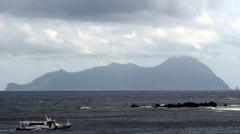For centuries, residents of central Japan celebrated the Miwatari, an ice ridge on Lake Suwa believed to signify a god's presence. Its recent absence has sparked worries about environmental imbalance and cultural heritage.
The Disappearing Miwatari: A Frozen Lake's Message to Japan

The Disappearing Miwatari: A Frozen Lake's Message to Japan
Amidst climate changes, the revered ice formation on Lake Suwa fades, raising concerns for local traditions and environmental balance.
In the heart of Japan, the mystical Lake Suwa has long been a source of wonder and reverence, particularly during winter when an ethereal natural phenomenon, the Miwatari, would grace its surface. This jagged formation of ice, likened to a dragon's spine, traditionally signified the presence of a wandering god in Shinto belief. For over six hundred years, local residents have cherished its arrival, gathering to honor the supernatural visitation it represents. The annual spectacle inspired awe but also acted as a reminder of balance in nature, with the absence of the Miwatari interpreted as a foreboding sign.
Local Shinto priest Kiyoshi Miyasaka has been part of this tradition for decades, witnessing the changing patterns of winter as the Miwatari often served as both a spiritual connection and a weather indicator. Each winter since 1443, the community has meticulously documented the Miwatari's appearances, ice conditions, and accompanying historical events. This annual register offers a rare glimpse into centuries of climate stability that seem to be fading.
As climate change leads to milder winters, the winters that once drew locals onto the ice now see increasing disappointment. The last significant formation of the Miwatari occurred in 2018, with subsequent winters leaving its return in doubt, stirring anxieties about ecological imbalance and cultural continuity. The Miwatari's disappearance reflects not only shifts in climate but also the potential loss of a vital cultural identity tied to historic weather patterns—a poignant reminder of how interconnected nature and tradition can be.
Local Shinto priest Kiyoshi Miyasaka has been part of this tradition for decades, witnessing the changing patterns of winter as the Miwatari often served as both a spiritual connection and a weather indicator. Each winter since 1443, the community has meticulously documented the Miwatari's appearances, ice conditions, and accompanying historical events. This annual register offers a rare glimpse into centuries of climate stability that seem to be fading.
As climate change leads to milder winters, the winters that once drew locals onto the ice now see increasing disappointment. The last significant formation of the Miwatari occurred in 2018, with subsequent winters leaving its return in doubt, stirring anxieties about ecological imbalance and cultural continuity. The Miwatari's disappearance reflects not only shifts in climate but also the potential loss of a vital cultural identity tied to historic weather patterns—a poignant reminder of how interconnected nature and tradition can be.



















